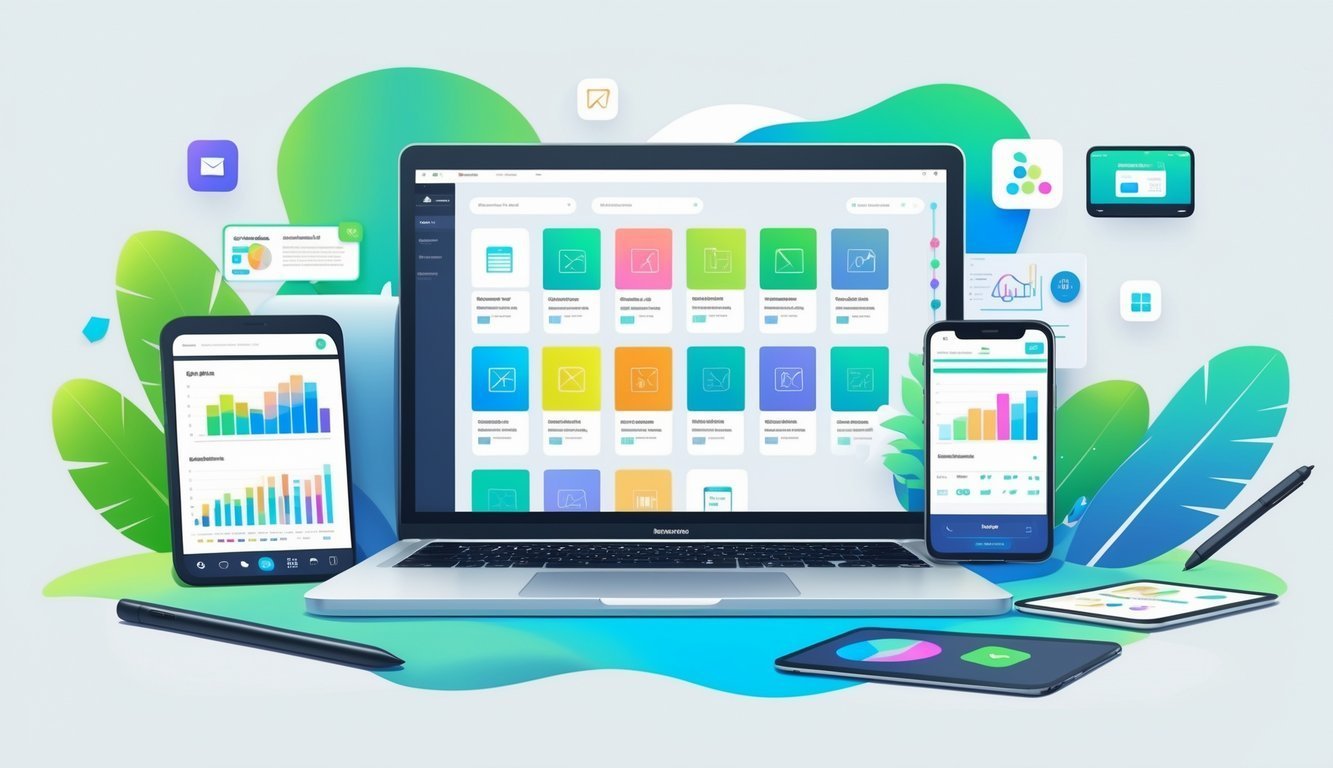PsychNewsDaily Publishers
100 Summit Drive
Burlington, MA, 01803
Telephone: (320) 349-2484
PsychNewsDaily Publishers
100 Summit Drive
Burlington, MA, 01803
Telephone: (320) 349-2484
Selling digital marketing templates offers a low-cost, efficient way to generate income online by providing ready-made designs for various marketing needs.

Selling digital marketing templates is actually a pretty clever way to make money online. These templates save businesses a lot of time by giving them ready-made designs and plans they can tweak however they like.
When you create and sell your own templates, you can start building a steady income and help out folks who need these tools.
You don’t need to be a design expert or a marketing pro to get started. Simple templates for things like social media, email campaigns, or ads do really well on Etsy and other marketplaces.
Knowing where to sell your templates—and how to make them appealing—can boost your sales way more than you might expect.
If you figure out how to price your templates, promote them, and stick to platform rules, you’ll stand out. With some effort and a bit of planning, you can watch your side business grow.

Before you jump in, get clear on what digital marketing templates are, who uses them, and what’s happening in the market. This really helps you create products that fit in and stand out at the same time.
Digital marketing templates are pre-made designs you can tweak for social media, emails, ads, and more. They save people time and help brands look consistent.
You can sell these on Etsy, Canva, or your own website. Make sure you check the rules for each platform—Canva, for example, has its own guidelines.
Buyers get these products instantly after paying. You don’t have to worry about shipping or inventory, so running this kind of business costs less and feels a lot simpler.
It helps a lot to know who wants to buy your templates. Your target audience might be small business owners, social media managers, or freelance marketers.
Think about the problems your audience faces. Maybe they need easy-to-use Instagram templates or something for email campaigns.
Decide if you’ll focus on beginners or more advanced users. This will shape how you design your templates.
Check out what other sellers offer to see what’s popular and what’s missing. Look at their template styles, pricing, and reviews.
Make a list of what types of templates sell best and spot any gaps. For example, if hardly anyone makes templates for fitness coaches, maybe that’s your niche.
Use this info to price your templates and make yours more appealing. Keep an eye on competitors so you can adjust and stay ahead.

To actually sell your templates, focus on making them look great, picking the right places to sell, and using smart marketing. Every step helps you reach more customers and start earning passive income.
Your templates should look polished and be easy to edit. Tools like Canva work well because most buyers already know how to use them.
Make sure you include features like editable colors, fonts, and layouts so people can make each template feel unique.
Don’t forget the basics—balance, contrast, and good fonts matter. Try to create templates for different needs, like social media, presentations, or email marketing.
Do a quick SWOT analysis on your designs. Figure out what makes them good, what could be better, where you can improve, and how you compare to others.
Where you list your templates really matters. Marketplaces like Etsy have lots of buyers searching for digital products, but you’ll pay fees and face more competition.
If you sell on your own website, you get more control over your brand and prices. But building up traffic takes patience and work.
A lot of sellers use both options. Start with Etsy for quick exposure, then slowly build your own site for more control. You could offer discounts or extras on your site to encourage direct sales.
Show people how your templates save time and look professional. Use social proof—things like customer reviews—to help build trust.
Plan promotions around launches or holidays to get more eyes on your products. Post on platforms where your audience hangs out, like Instagram or Pinterest, and tailor your content to fit.
Set aside a bit of money for ads. Consider working with affiliates who can help spread the word. Build an email list so you can send updates or special deals.
Make your marketing messages clear. Show how your templates help businesses create good-looking marketing materials fast, even if they’re not design experts.

You’ll see how to make your own templates, pick the best places to sell, and handle legal stuff. There are also tips for pricing and promoting your templates, plus why offering a freebie can help.
Pick a tool like Canva, Adobe Illustrator, or Google Slides. Keep your layouts clear and easy to change. Try not to overcomplicate things so buyers can edit them without hassle.
Etsy, Shopify, and Creative Market are popular choices. These sites have built-in buyers and make payments simple.
You can also try selling on your own website if you want more control.
Make sure you own everything in your templates or have permission to use it. Don’t use copyrighted images or fonts unless you’ve got a license. Add clear terms so buyers know how they can use your templates.
Check out what other sellers are charging for similar templates. Think about the time you put in and the value you offer.
Pricing too low can make your work seem less valuable, but setting prices too high might scare off buyers.
Share examples and reviews on social media. Use professional-looking product images.
Try offering a limited-time discount to get your first buyers interested.
Absolutely, you can give away your digital marketing templates for free. Doing this builds trust and helps you connect with more people.
You’ll collect emails for your marketing list, which is always a win. Plus, sharing free templates lets you show off your design skills in a real way.
Sometimes, people who grab your free templates decide to buy your paid ones later on. That’s a nice bonus.